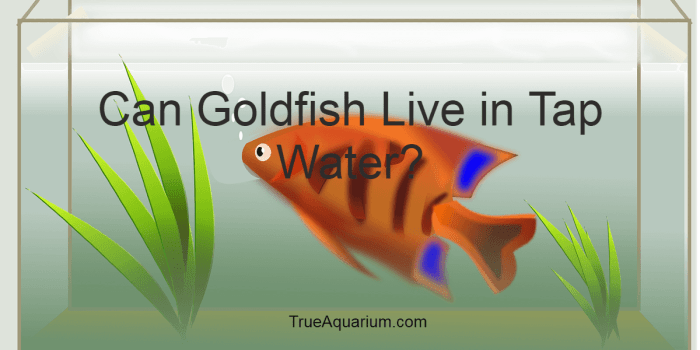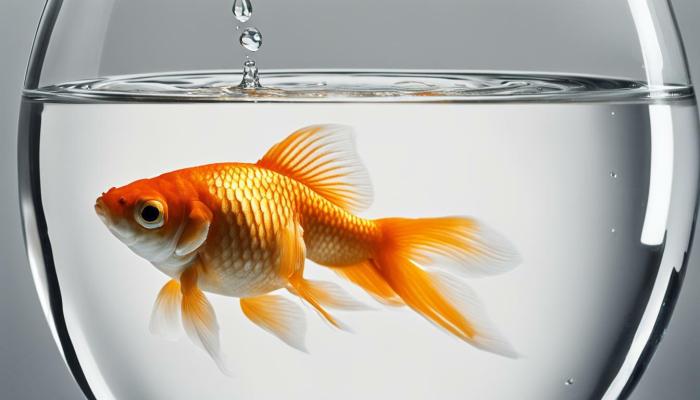Can goldfish go in tap water? While it may seem like a simple question, the answer is more complex than you might think. Goldfish, like all aquatic creatures, are sensitive to water quality, and tap water often contains elements that can be harmful to their health.
From chlorine and chloramine to heavy metals and other contaminants, understanding the potential risks and solutions is crucial for keeping your goldfish happy and healthy.
This guide delves into the chemistry of tap water and its impact on goldfish, exploring the potential dangers and providing practical advice on how to safely use tap water for your aquarium. We’ll cover essential topics like chlorine removal, water hardness, and alternative water sources, ensuring you have the knowledge to create a thriving environment for your finned friends.
Water Hardness and pH
Water hardness and pH are crucial factors influencing the health and well-being of goldfish. Understanding these parameters and maintaining optimal levels in their tank environment is essential for their long-term survival and thriving.
Water Hardness
Water hardness refers to the concentration of dissolved minerals, primarily calcium and magnesium, in water. It is measured in parts per million (ppm) or milligrams per liter (mg/L) of calcium carbonate (CaCO3).
- Hard waterhas a high mineral content, typically above 175 ppm CaCO3.
- Soft waterhas a low mineral content, typically below 60 ppm CaCO3.
- Moderate waterfalls between these two extremes.
Goldfish, being native to relatively hard water environments, generally thrive in moderately hard water. Excessive hardness can lead to mineral build-up in the tank, impacting water quality and potentially causing health problems. Conversely, very soft water can make it difficult for goldfish to absorb calcium, leading to skeletal deformities and other issues.
pH
pH is a measure of the acidity or alkalinity of water, ranging from 0 to 14, with 7 being neutral.
- Acidic waterhas a pH below 7.
- Alkaline waterhas a pH above 7.
Goldfish prefer slightly alkaline water, with an ideal pH range of 7.0 to 7.6.
Optimal pH levels for goldfish tanks are generally between 7.0 and 7.6.
While tap water can be harmful to goldfish due to chlorine and other chemicals, providing them with a healthy diet is crucial. You might be wondering if carrots are a safe treat for your finned friends, and the answer is a resounding yes! Can Goldfish Eat Carrots: A Guide to Safe Veggie Treats provides all the information you need to ensure your goldfish enjoy a nutritious and balanced diet.
Just remember to always use dechlorinated water for your goldfish, and they’ll be swimming happily for years to come.
Fluctuations in pH can stress goldfish, making them susceptible to diseases. A sudden drop in pH can be particularly harmful, leading to ammonia poisoning and other health problems.
Adjusting Water Hardness and pH
Tap water hardness and pH can vary significantly depending on location. Adjusting these parameters to suit the needs of goldfish is often necessary.
Adjusting Water Hardness
- Hard watercan be softened by adding a water softener to the tank. However, using a softener can deplete the water of beneficial minerals. Alternatively, adding a small amount of aquarium salt to the tank can help to increase water hardness.
- Soft watercan be hardened by adding a water conditioner specifically designed for this purpose. These conditioners contain calcium and magnesium salts, which increase the water’s hardness.
Adjusting pH
- Acidic watercan be neutralized by adding a pH buffer or a small amount of baking soda to the tank. However, adding baking soda should be done cautiously, as excessive amounts can raise the pH too quickly.
- Alkaline watercan be acidified by adding a pH reducer to the tank. These reducers typically contain citric acid or other organic acids.
It’s crucial to use water conditioners and pH adjusters designed specifically for aquariums. Always follow the product instructions carefully to avoid harming your goldfish.
Goldfish Health and Well-being

While tap water can be used for goldfish, it’s crucial to understand the potential health risks and take steps to ensure a healthy environment for your aquatic companions.
Potential Health Risks of Tap Water
Tap water often contains chlorine and chloramines, chemicals added to kill harmful bacteria. While these chemicals are beneficial for human health, they can be harmful to goldfish. Chlorine and chloramines can irritate the fish’s gills, leading to respiratory problems, stress, and even death.
Additionally, tap water may contain heavy metals, minerals, and other impurities that can negatively impact goldfish health.
Signs of Stress and Illness in Goldfish
Recognizing the signs of stress and illness in goldfish is essential for timely intervention. Here are some common symptoms:
- Loss of appetite: A goldfish refusing to eat is a significant indicator of stress or illness.
- Lethargy: A goldfish that is usually active and playful may become lethargic and spend most of its time at the bottom of the tank.
- Rapid breathing: If a goldfish is breathing rapidly at the surface of the water, it may be experiencing respiratory distress.
- Changes in coloration: A goldfish’s color can fade or become dull, indicating stress or illness.
- Fins clamped together: Goldfish with clamped fins may be experiencing stress or discomfort.
- White or cloudy spots: These can indicate fungal or bacterial infections.
- Swollen belly: This could be a sign of internal parasites or other health issues.
Maintaining a Healthy Environment, Can goldfish go in tap water
While tap water can be used for goldfish, it’s essential to create a healthy environment for them to thrive. Here are some tips:
- Dechlorinate the water: Always dechlorinate tap water before adding it to your goldfish tank. Use a water conditioner specifically designed for aquariums to remove chlorine and chloramines.
- Test water parameters regularly: Monitor the water’s pH, ammonia, nitrite, and nitrate levels using a test kit. Aim for a pH of 6.5-7.5, and keep ammonia, nitrite, and nitrate levels as close to zero as possible.
- Perform regular water changes: Change 25-50% of the tank water weekly to remove accumulated waste and maintain water quality.
- Provide a suitable tank size: Goldfish require a large tank. A general rule is 10 gallons of water for the first goldfish and 5 gallons for each additional goldfish.
- Use a filter: A good filter is essential for removing waste and keeping the water clean.
- Offer a varied diet: Feed your goldfish a balanced diet of high-quality goldfish flakes, pellets, and occasional treats like live or frozen brine shrimp.
Preventing and Addressing Health Issues
Maintaining a healthy environment can help prevent health issues in goldfish. However, even with proper care, goldfish may experience occasional problems.
- Regular tank maintenance: Regular water changes, cleaning the tank, and ensuring proper filtration are crucial to prevent disease.
- Quarantine new fish: Before introducing new fish to your existing tank, quarantine them in a separate tank for at least two weeks to observe their health and prevent the spread of disease.
- Seek professional advice: If you notice signs of illness in your goldfish, consult a veterinarian specializing in aquatic animals. They can diagnose the problem and recommend appropriate treatment.
Final Wrap-Up: Can Goldfish Go In Tap Water

By understanding the potential risks and taking necessary precautions, you can confidently use tap water for your goldfish tank. Remember, regular water testing, proper filtration, and a well-maintained aquarium are essential for keeping your goldfish healthy and happy. With a little knowledge and effort, you can provide a safe and enjoyable environment for your aquatic companions.